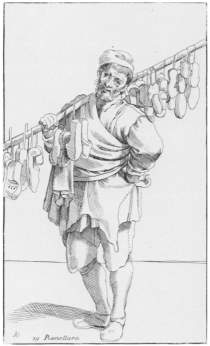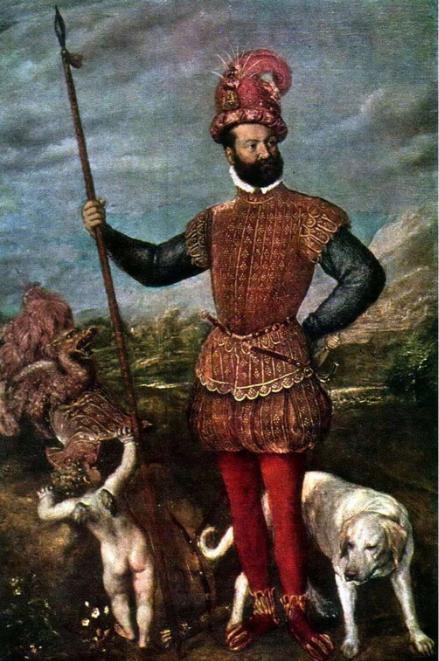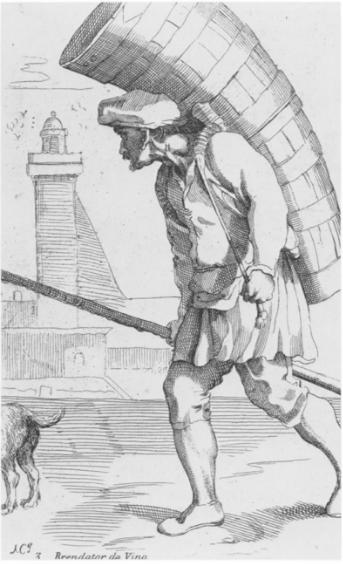Mobility and Famine in Annibale Carracci’s ‘Straordinario di Carne’
| ✅ Paper Type: Free Essay | ✅ Subject: Arts |
| ✅ Wordcount: 2760 words | ✅ Published: 03 Nov 2020 |
Mobility and Famine in Annibale Carracci’s ‘Straordinario di Carne’: Reconstructing Urban Space through Keplerian Astronomy
Annibale Carracci’s ‘Straordinario di Carne’ [fig. 1] from the ‘Arti di Bologna’ series is a drawing executed circa 1580 of two figures – a street vendor handling meat and an elderly lady with a basket. This mundane encounter, hardly a scene due to the minimal rendering of the space, was repurposed after Carracci’s death in a folio volume for the Roman public in 1646. Genre scenes, especially of labourers, have been couched in moral edification and taxonomy. Art historian Sheila McTighe traces the work back to these art-making practices, referencing painters and print makers Vincenzo Campi and Ambrogio Brambilla.1 For McTighe, Carracci updated these preceding trails of thought, either by visually inverting the satire or isolating the procession of figures to satisfy the market’s demand for the urban, ethnographic interest. This scholarship orbits around the body – its disfiguration, imitation and ordering into habits – at times overshadowing the space in which the body is plotted. This disables the body to the point of sweeping generalisations of the low ‘class’ – a term argued to be an invention of the eighteenth century – and status as an automaton.2
I urge for a consideration of geometrical imagination, in order disassociate these visual changes from McTighe’s collective imaginaire and encyclopaedic curiosity. With reference to 17th century reconceptualisation of celestial bodies and their trajectories in astronomy, led by the mathematician Johannes Kepler who formed part of the larger Copernican Revolution, Carracci’s space is programmed by social mobility and histories of famine. Piero Camporesi, in his Early Modern study of hunger and hallucination, indeed flirts with ‘non-Euclidic geometry’ and ‘popular vision of the deformed, unmeasured, hyperbolical’.3 However, the historian never expands on these concepts. As celestial bodies deviate from their orbits into an ellipsis and the cosmos stellates into three-dimensional polyhedra, I draw limits to the scholarship of inverting social class and the taxonomical vantage point. Treatment of space in Carracci’s print is what truly makes it counter-hegemonic, and what comes to encompass its multidimensional, communal audience.
Comical undertones have often revealed themselves in genre painting, perceived by art historians such as McTighe as tools for social sensibility – a term which requires unpacking.4 Social sensibility is the effect of moral edification from a vulgar image. The effect bases itself on a very one-dimensional audience formed by higher classes. The ‘Arti di Bologna’ prints have indeed been argued to be repurposed after the artist’s death for the Roman elite.5 This allows for a subordination of manual labourers, visible in works of Vincenzo Campi. ‘The Kitchen’ of 1580 [fig. 2] is an anecdotal narrative plotted with disfiguring and simultaneously living/dead bodies. The boy sat down in the bottom left corner of the canvas is blowing his cheeks to the point of facial deformation, meanwhile another young man in the top right shrivels his face up. The household cat is diluting its life into death by perching up on freshly extracted organs as though they are its tucked tail. For McTighe, this vulgarity brings out the ‘lower-class grossness’ of produce and the bodies that encircle it.6 There is therefore a unidirectional flow of satire directed exclusively at the lower classes, who are grouped under the villano to embody both rural dwellers and urban labourers.7
Carracci’s ‘Straordinario di Carne’ does not adhere to the grotesque visualisations of lower-class satire, which McTighe deems as counter-hegemonic and necessarily inverse.8 Although this is a thread throughout all of the artist’s genre works, it is in ‘The Butcher Shop’ [fig. 3] of the 1580s that the inverted satire is so visible. The stall workers, busy with handling and weighing meat, are struck with two highly idiosyncratic customers. The frailness of the halberdier is exemplified in his struggle to reach his pocket, while the hook-nosed old woman embodies the ill-tempered ruffiana archetype.9 The woman, despite being placed on the furthest pictorial plane, calls forattention through her detailed expression; meanwhile half of the worker’s faces are hidden under obscure angles. The woman reappears in ‘Straordinario di Carne’ as one of the two protagonists; exporting with her satirical inversion. Meanwhile the labourers are carrying imports of noble gestures. A crude assimilation between the living and the dead is therefore swapped over with the conflation of gestures and poses of the noble and those who labour. Another print from the ‘Arti di Bologna’ series – ‘Pianellaro’ [fig. 4] – features a clog-seller whose arm rests on his hip with a protruding elbow; very similarly to the pose of Titian’s ‘The Portrait of the Duke of Asti’ [fig. 5].10 The inversion allows McTighe to restructure the one-dimensional noble viewer into a collective imaginaire.
The term imaginaire reappears throughout McTighe’s works, signifying the collective share of mental images.11 It humbles the aforementioned works into perceptions rather than observations, framing comedy and imitation as a motivic force of reasserting social hierarchy, if the viewer is indeed a nobleman that favours such class delineation. However, as this is a collective imagination, the labourers too have the possibility of forming part of the audience. Yet, McTighe spatialises the villano-onlooker as being ejected. In the context of satirical carnival songs that bear the samecharacter as Campi’s ‘The Kitchen’, the ‘mimicking […of] low-life characters […distances] their audience even further from their world’.12 The plural use of audience not only suggests the varied class collective, but also taints the satirical image with inward shame of the labour audience. Does McTighe wrongly assume that the villano had the desire to disassociate from their existing position? And therefore, that such division of class was even conscious? Her argument for the counter-hegemony of the work is thus somewhat counter-productive. Emulating nobleman’s gestures clarifies the hierarchy to begin with, as the imitating, lower class is inferior and shameful of itself. This counter-narrative is thus an even stronger homogenising force, as any attempt to pervert the vertical hierarchy results in a satire from below. The imaginaire concept also has debilitating effects on the agency of the body, purposing it solely as an imaginative marker of reassertion or an even more asserting inversion.
What has been overlooked in the body-oriented analyses of vulgarity and upper-class emulation is the space in which that very body is positioned – which bears the potential for reconceptualising Carracci’s work as truly counter-hegemonic. This goes beyond marking out the habitat of these Bolognese street vendors, such as the tower in Carracci’s ‘Brendator de Vino’ [fig. 6]. 17th century mathematician Kepler destabilised the authority of ancient – formalised as ‘Euclidean’, despite contributions from Plato and Aristotle – conceptions of geometry and its applications in astronomy. The social climate of Europe too, due to the rise in trade activities, experienced both upward and downward class mobility. Unlike the law of derogation in France that stripped the aristocracy of their titles if they engaged in the trade, Italy had a far more embracing milieu.13 The figure of the straordinario is the product of such unfolding. Not only has there been confusion as to what the Italian word translates to – proposed by Roberto Zapperi to mean ‘a merchant of unusual objects’ – but the current interpretation of the word defines him as a legal overseer of merchant activity.14 His steelyard harks to the straordinario task of weighing meat in defence of the vices of short-weighing, which would be dealt with by public beating.15 In place of McTighe’s collective imagination, I argue for geometric imagination. More specifically, how the discovery of movement of celestial bodies, including the previously immobile earth, in an ellipsis instead of the Greek epicycles shadowed class mobility. These elliptic orbits also challenge McTighe’s conceptions of inversion happening within bodies defined by class. As such, we can map theory of celestial bodies onto sublunary ones. Greek mathematicians delineated a hierarchy of shapes declaring that only the uniform, two-dimensional circle is fit for the superlunary world, whilst the five Platonic three-dimensional solids, or regular polyhedra, ranging from icosahedron for water to the cube for earth.16 Their movement is directly influenced by geometric composition, meaning that superlunary bodies had solely flat, circular orbits.17 Kepler, having rethought the circular movement as an elliptical one, introduced the concept of the body deviating from its orbit. This deviation, called orbital eccentricity, is in fact essential for the formation of the ellipsis, while its apsides are the further and nearest points on the orbital path reached by the body in relation to its host.18 The mobile impulse found within classes are therefore behaving similarly to celestial mechanics. Instead of a movement of inversion, predicated on a central, immobile upper class (much like the Earth) we observe a spatial deviation. There is potential therefore for the print to be counter-hegemonic not in its satirical ruffiana, or emulation of the noble classes through the authority of straordinario, both suggesting a performative, inauthentic body that is ashamed of itself. Instead, it is the ambiguous and therefore mobile status of the central figure, as well as its visually peripheral positioning away from the compositional centre through deviation, pushing the figures to the left side.
Alongside the departure of Carracci from comical undertones directed at the labourer, we ought to consider the taxonomical feature articulate in print culture at the time. Art historians Melissa Calaresu and Deborah Krohn see this ethnographical interest in itself as a passage streaming away from satire.19 Yet, I would argue that both traditions, although visually updated by Carracci, unfairly disable the body and disagree with each other. Carracci’s work has been received as part of Ambrogio Brambilla broadsheets as well as the tradition of representing customs and costumes in print. Brambilla’s ‘Ritratto di quelli che vanno vendendo’ [fig. 7] from around the same time (1582) as Carracci’s print shows the spatial grid vocabulary that has been described as cris de Paris – street criers.20These composite prints would often be accompanied by text, as seen in therows inserted between the processions of workers in Brambilla’s print. Campi’s management of multiple planes in ‘The Kitchen’ also presents an encyclopaedic vantage point, making Carracci’s print appear more natural in terms of perspective. Carracci isolates the straordinario labourer into a single, empty composition. Despite these differences, which we will later make sense of in terms of sharply-edged polyhedral space, the choice to publish Carracci’s prints in a folio volume unquestionably harks back to the comparative features of taxonomy. For Calaresu, taxonomy offers far more ‘spontaneous and authentic expressions of popular urban life’; an argument incongruous to McTighe’s subjective, collective imaginaire.21 This fulfils the demand for scientific curiosity, fuelled later by tourists of the Grand Tour, in place of class delineation and mockery from the two sides.22 In both cases, however, the body is a mere automaton, as Krohn admits herself in analysis of Bartolomeo Scappi’s kitchen prints in the ‘Opera’ series [fig. 8] where labourer’s bodies are extended into mere tools, function of which they demonstrate.23 The tension between the two arguments, facilitated by utilising alien bodies of labour, can be resolved with consideration of space recently tweaked, again, by Kepler.
Mathematical conception of space is the gulf between documentation through calculation and abstraction – forming an intermediary between McTighe’s and Krohn’s thought. When satire and taxonomy come together to repress the body, space, at times of crisis, resurrects the collective audience proposed by McTighe and shared expression promoted by Krohn. Piero Camporesi’s ‘Bread of Dreams’ explores this moment of hallucinogenic unfolding in the famines of 1590s Northern Italy. The figure of the straordinario can therefore be seen as an authority that is a reminder of the food vendors’ habits of short-weighting in response to the shortages that they face, which came to impact everyone. McTighe’s communal, mental nexus of imaginaire is therefore measurements of ‘non-Euclidic space […] introduced by the culture of hunger’, one that is indeed ‘hyperbolical’ – a term used to describe Keplerian geometry.24 While Krohn’s strive for popular, ethnographic descriptions is satisfied through ‘popular vision of the deformed’.25 Empty stomachs of starvation appeal through a minimal envisioning of urban space in Carracci’s print. The mathematician proposed stellation in the context of the cosmos, in order for the two-dimensional, Euclidean geometric shapes that define the shape of our universe to extend into three-dimensions.26 This also meant that the preceding, layered model consisting of flat circles (commonly depicted in medieval manuscripts) would be replaced [fig. 9]. Any given polyhedra, be it an icosahedron between Earth and Venus or an octahedron between Mercury and Venus, would thus be born into a sharp-edged character with far more narrow angles [fig. 10].27 As an effect, the multi-faceted vantage point observed in Campi and processions of Brambilla for the purpose of taxonomy would no longer be conceivable. Spatial landscapes would be far too upturned and chaotic to construct such a tantalising viewpoint. The absence of a clearly demarcated urban space therefore is a sober realisation of the impotence of the Euclidean geometry, instead of the body, that is coupled with ‘seeing the sky burst’ in times of hunger.28
Having considered first the figures of ‘Straordinario di Carne’, reinterpreting their comical and imitative features with mobility and decentralised composition; and then the empty space in which they are plotted, disassociates Carracci’s print from preceding visualisations of labour. This makes the work counter-hegemonic and considers a multi-dimensional audience. However, this has not been achieved through inversion or its taxonomical folio format that satisfies vision shared by all classes. These arguments, based on a shameful body of the villano imitator and extension of encyclopaedic labour are equally homogenising and disabling, and assumes the debatable notion of class. Discourse of the body also creates scholarly tension as to whether it is documentary or imaginative. Instead, in line with emerging thought on orbital ellipsis and structure of the universe, the work reveals social mobility and a destabilising history of famine.
List of Illustrations

Figure 1: Annibale Carracci, Straordinario di Carne, 1646, Etching on paper, 275 x 165 mm

Figure 2: Vincenzo Campi, The Kitchen, 1590-1, Oil on canvas, 145 x 220 cm, Pinacoteca di Brera, Milan

Figure 3: Annibale Carracci, The Butcher Shop, c. 1583, Oil on canvas, 185 x 266 cm, Christ Church Picture Gallery, Oxford

Figure 4: Annibale Carracci, Pianellaro, 1646, Etching on paper

Figure 5: Titian, Portrait of the Duke of Asti, 1551-52, Oil on canvas, 230 x 153 cm, The Old Masters Art Gallery, Kassel

Figure 6: Annibale Carracci, Brendator de Vino, 1646, Etching on paper

Figure 7: Ambrogio Brambilla, Ritratto di quelli che vanno vendendo, 1582, Print

Figure 8: Bartolomeo Scappi, Camera propinqua, 1570, Print, Department of Printing and Graphic Arts, Houghton Library, Harvard College Library

Figure 9: Abraham Cresques, Catalan Atlas, 1375, Illuminated manuscript, 37.8 x 49.5 cm

Figure 10: Johannes Kepler, View of universe based on regular polyhedra, 1596, Engraving
Bibliography
Boccaletti, Dino, ‘From the Epicycles of the Greeks to Kepler’s Ellipse’, Cosmology Through Time, (2001), 1-14
Camporesi, Piero, Bread of Dreams: Food and Fantasy in Early Modern Europe (Cambridge: Polity Press, 1989)
Calaresu, Melissa, Not Dead Things (Leiden: Brill, 2013)
Krohn, Deborah, ‘Picturing the Kitchen: Renaissance Treatise and Period Room’, Studies in the Decorative Arts, 16 (2008), 20-34
Luminet, Jean-Pierre, ‘Science, Art and Geometrical Imagination’, The Role of Astronomy in Society and Culture, 260 (2009), 248-273
Martin, John Rupert, ‘The Butcher’s Shop of the Carracci’, The Art Bulletin, 45 (1963), 263-266
McTighe, Sheila, ‘Perfect Deformity, Ideal Beauty, and the ‘Imaginaire’ of Work: The Reception of Annibale Carracci’s ‘Arti di Bologna’ in 1646’, Oxford Art Journal, 16(1993), 75-91
‘Foods and the Body in Italian Genre Paintings, about 1580: Campi, Passarotti, Carracci’, The Art Bulletin, 86 (2004), 301-352
Zapperi, Roberto, Annibale Carracci: Ritratto di artista da giovane (Turin: Einaudi, 1989)
1 Sheila McTighe,‘Foods and the Body in Italian Genre Paintings, about 1580: Campi, Passarotti, Carracci’, The Art Bulletin, 86 (2004), 301-352 (p.301).
2 Piero Camporesi, Bread of Dreams: Food and Fantasy in Early Modern Europe (Cambridge: Polity Press,1989), p. 36.
3 Ibid p. 79.
4 McTighe p. 304.
5 Melissa Calaresu, Not Dead Things (Leiden: Brill,2013), p. 201.
6 McTighe p. 315.
7 Ibid p. 316.
8 McTighe,‘Perfect Deformity, Ideal Beauty, and the ‘Imaginaire’ of Work: The Reception of Annibale Carracci’s ‘Arti di Bologna’ in 1646’, Oxford Art Journal, 16(1993), 75-91 (p. 75).
9 McTighe p. 315. 10 McTighe p. 85. 11 Ibid p. 75.
12 Ibid p. 85.
13 McTighe p. 80.
14 Roberto Zapperi, Annibale Carracci: Ritratto di artista da giovane (Turin: Einaudi, 1989), p. 61.
15 McTighe p. 84.
16 Jean-Pierre Luminet, ‘Science, Art and Geometrical Imagination’, The Role of Astronomy in Society and Culture, 260 (2009), 248-273 (p. 249).
17 Dino Boccaletti, ‘From the Epicycles of the Greeks to Kepler’s Ellipse’, Cosmology Through Time, (2001), 1-14 (p. 2).
18 Ibid p.11.
19 Deborah Krohn, ‘Picturing the Kitchen: Renaissance Treatise and Period Room’, Studies in the Decorative Arts, 16 (2008), 20-34 (p. 20).
20 McTighe p. 78.
21 Calaresu p. 183.
22 Ibid p. 182.
23 Krohn p. 30.
24 Camporesi p. 18.
25 Ibid p.79.
26 Luminet p. 252.
27 Ibid p. 267.
28 Camporesi p. 129.
Cite This Work
To export a reference to this article please select a referencing stye below:
Related Services
View allDMCA / Removal Request
If you are the original writer of this essay and no longer wish to have your work published on UKEssays.com then please click the following link to email our support team:
Request essay removal



